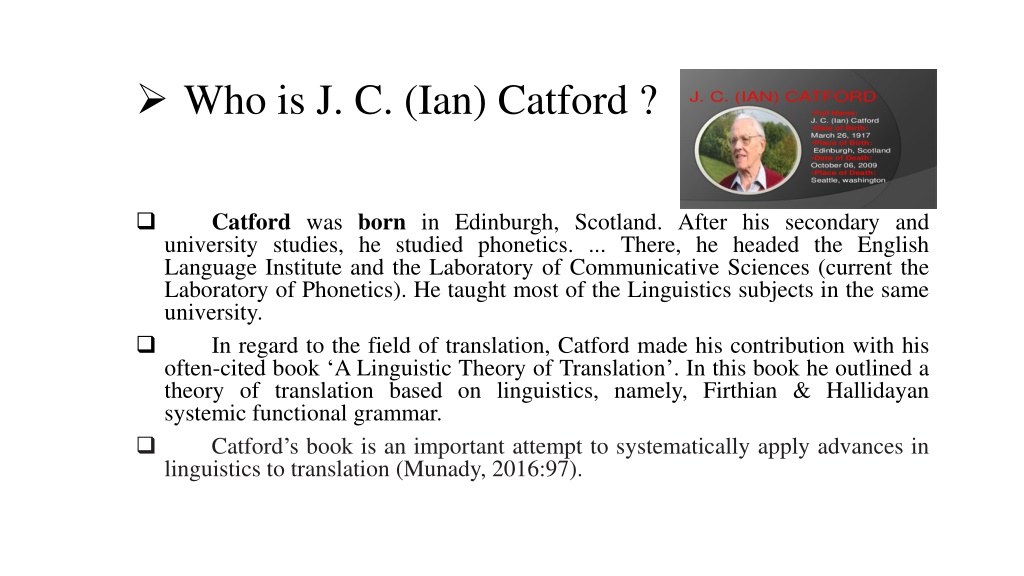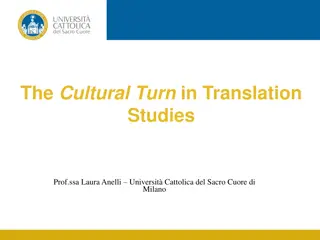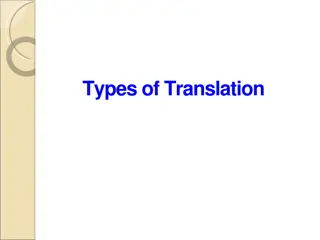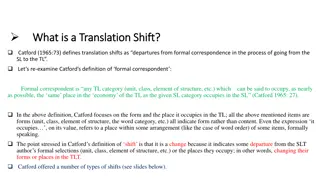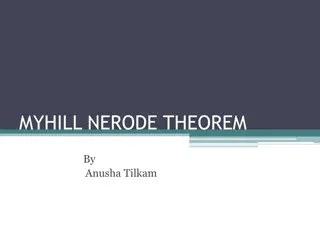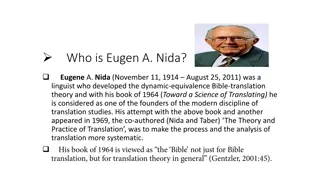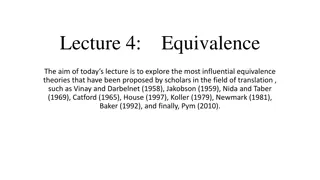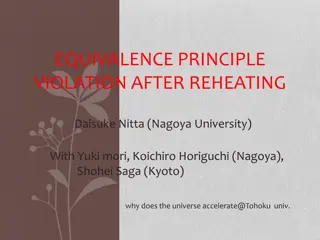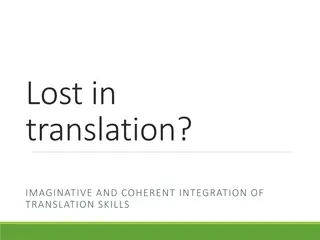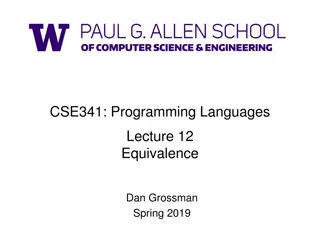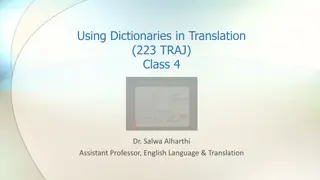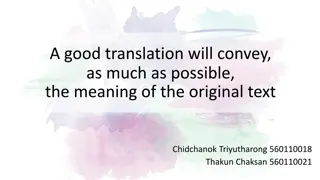Understanding J.C. Catford's Linguistic Theory of Equivalence in Translation
J.C. Catford, a prominent figure in translation studies, developed a theory of equivalence in translation based on functional linguistics. His work emphasizes the process of substituting text from one language to another, focusing on formal and textual equivalence. Catford's theory sheds light on how translators can achieve equivalence while considering linguistic differences between languages.
Download Presentation

Please find below an Image/Link to download the presentation.
The content on the website is provided AS IS for your information and personal use only. It may not be sold, licensed, or shared on other websites without obtaining consent from the author. Download presentation by click this link. If you encounter any issues during the download, it is possible that the publisher has removed the file from their server.
E N D
Presentation Transcript
Who is J. C. (Ian) Catford ? Catford was born in Edinburgh, Scotland. After his secondary and university studies, he studied phonetics. ... There, he headed the English Language Institute and the Laboratory of Communicative Sciences (current the Laboratory of Phonetics). He taught most of the Linguistics subjects in the same university. In regard to the field of translation, Catford made his contribution with his often-cited book A Linguistic Theory of Translation . In this book he outlined a theory of translation based on linguistics, namely, Firthian & Hallidayan systemic functional grammar. Catford s book is an important attempt to systematically apply advances in linguistics to translation (Munady, 2016:97).
Catford Catford s s Linguistic Theory of Equivalence: Theory of Equivalence: Translation for Catford is an operation performed on languages: a process of substituting a text in one language for a text in another. And it is clear that his definition is a process-focused one as indicated by the ing of substituting . Catford believes that any theory of translation must draw on a theory of language, a general linguistic theory, whose linguistic categories can be used to describe & analyze the translation process. He had based his translation theory on functional linguistics of Firth and Firth s student Halliday Catford builds his definition on the concept of equivalence, describing translation as the replacement of textual material in one language by equivalent textual material in another language. Catford offered a number of types of translation according to three variables (extent, rank, and level, see the slides below) whereby equivalence can be sought. He differentiated between two types of equivalence: formal correspondent & textual equivalence (see slides below for definition and details)
Types of Equivalence: Formal correspondent is any TL category (unit, class, element of structure, etc.) which can be said to occupy, as nearly as possible, the same place in the economy of the TL as the given SL category occupies in the SL (Catford 1965: 27). Catford s Types of Equivalence Formal Correspondent Textual equivalent, however, is defined by Catford as any TL text or portion of text which is observed on a particular occasion [...] to be the equivalent of a given SL text or portion of text (p. 27). Textual Equivalent
Formal Correspondent: Catford s formal correspondence is a useful tool to be used in comparative linguistics and translation teaching (Al-Manna, 2013). Formal correspondence is a more general system-based concept between a pair of languages. It aims to cover the form and the content of the SL in the TT as much as possible. Hence, in translation process, translators have to reproduce various formal items such as the meanings in terms of the SL context, consistency in word usage, and grammatical units. The reproduction process at the lexical and grammatical levels contains (1) preserving all phrases and sentences intact, i.e. preserve the units format and structure, and (2) translating verbs by verbs, nouns by nouns, etc. In such a translation, the grammatical segments are usually reproduced and the wording is almost literal, thus the final corresponding units can be easily compared. Such comparable grammatical categories or units in the translation from English to Arabic or vice versa are rarely obtained and cases are the exceptions rather than the rule. Thus, due to the differences between languages linguistic systems shifts are always taking place between the two languages and the equivalence achieved is the textual one rather than the formal correspondent. . E.g. We are reading the lecture =
Textual Equivalent: The discovery of textual equivalents is based on the authority of a competent bilingual informant or translator (Catford, 1965:27). Thus, it could be inferred that the translator can be seen as an assessment criterion to be used in assessing the final product; but how? Catford does not give an answer. Catford offered a test (a formal procedure termed commutation for any textual equivalent, in his words, we systematically introduce changes into the SL text and observe what changes if any occur in the TL text as a consequence . Textual equivalence is that portion of a TL text which is changed when and only when a given portion of the SL text is changed . Let s take this example: The translator is working out the English text. . If we change the English definite article the into an indefinite article a : A translator is working out the English text. . The change in meaning caused by the change in the definiteness system is the clue that the Arabic translation is the textual equivalent of the English one.
Types of Translation According to Catford ( Types of Translation According to Catford (1965 1965): ): Translation According to Extent Level Rank Rank-bound Translation Total Restricted Translation Full Translation Translation Rank- unbound Translation Partial Translation Phonological Translation Graphological Translation Grammatical Translation Lexical Translation
Translation According Translation According to to Extent Extent Full Translation is when the entire text is submitted to the translating process; every element in the SLT is replaced by a TL material; an example of this type is: . (I have put) (the book) (on the table). Partial Translation is when some elements of the SLT are left untranslated and simply transferred to, accommodated in, and/or transliterated into the TLT; an example of this type is as follows: . The computer is slow. computer is transferred by transliteration & the verb is is deleted, i.e. being accommodated to the TL (Arabic) system of grammar.
Translation According to Rank: Grammatically, rank refers to scale of categories hierarchically starting with the morpheme, upward to word, phrase, clause, sentence, and text. In rank-bound translation, the selection of the TL equivalence is limited at only one rank, such as morpheme for morpheme, word for word, etc. This type of translation will lead to bad translation , i.e. translation in which the TL text is either not a normal TL form at all, or is not relatable to the same situational substance as the SL text (Catford 1965/2004: 143). Example of this type could be (if we work one the sentence level): Rank-Bound Translation Rank-based Translation Unbound Translation (ST) Your course is translation theories. . ) ( (TT) And, as you see the result is unreadably awkward, distorted translation. Whereas rank-unbound translation means that the translator is free/untied to move through the rank scale , potentially seeking equivalence on the ranks of morpheme, word, etc. Examples of this type could be: (ST) . Which is one (morphologically condensed) word, can be translated to a full sentence: I love you.
Total Translation: Translation Translation According to According to Level Level Total translation is defined as "the replacement of source language grammar and lexis by equivalent target language grammar and lexis with consequential replacement phonology/graphology by (non-equivalent) phonology/graphology" (Catford, 1965:2). This equivalent can be obtained if we have languages of the same origin where grammatical systems are close to each; but in the case of English and Arabic, only rare cases and on restricted ranks could fit this definition (word or phrase, but not a full sentence where shifts must occur). See the examples below: (Lexical equivalent is obtained) ) We have shifted the word order ). of source target language language Translation According to Level Translation Total translation Total Restricted Translation Translation Restricted Translation: Restricted translation means "the replacement of source language textual material by equivalent target language textual material at only one level" (1965, 22); this type of translation is sub-branched into four types according to the level: phonological, graphological, grammatical, and lexical translation. Below are an example for each:
Phonological translation, Here, the SL phonology of a text is replaced by the equivalent TL phonology; this could happen in translating sounds in audio-visual translation (dubbing in particular; the case of laughing , or crying), or the hissing sound of the snake in a written text (the English ssssss) is translated in Arabic into ; more, the hhhhhhhhhhh sound which is the equivalent to the Arabic sound in , both means laughing . Graphological Translation is when the SL graphology of a text is replaced by equivalent TL graphology; graphological units are represented through 'transliteration' only: Transliterations which are usually accommodated to the TL phonological system: = falafel, democracy = , Sara = , and the like, could serve as examples of this. Grammatical Translation can be defined as 'restricted' translation where the grammar of the SLT is replaced by equivalent grammar in the TLT. Catford (1965:71) holds that the lexis (lexical elements, but not grammatical items) will not be replaced in this type. His example: This is the man I saw = haada l-man ili see t-u = As it is clear a highly distorted Arabic equivalent which wouldn t work in Arabic. Lexical Translation where the lexis (not the grammar) of the SLT is replaced by equivalent lexis in the TLT. The same example cited by Catford (ibid:72): This is the rajul I shuf-ed = . Again this translation does not work in Arabic. Restricted Restricted Translation: Translation: Phonological translation Restricted Translation Graphological Translation Grammatical Translation Lexical Translation
Criticisms of Catfords Approach to Equivalence: Although Catford s formal correspondence is a useful tool to be used in comparative linguistics and translation teaching, it seems that it is not really relevant in terms of assessing translation equivalence between ST and TT. Further, the translation process cannot simply be reduced to a linguistic exercise, as claimed by Catford, since there are also other factors, such as textual, cultural and situational aspects, etc., which need to be given full consideration when translating (Snell-Hornby 1988). Catford s approach to equivalence does not go beyond the level of the sentence, i.e. the whole text, and most of the examples he cited are decontextualized ones, not taken from real translations. Moreover, he didn t seem to account for the special character of and the differences between the languages he used in his examples; the Arabic translations (grammatical and lexical types of translation) are good examples of highly distorted final products.
